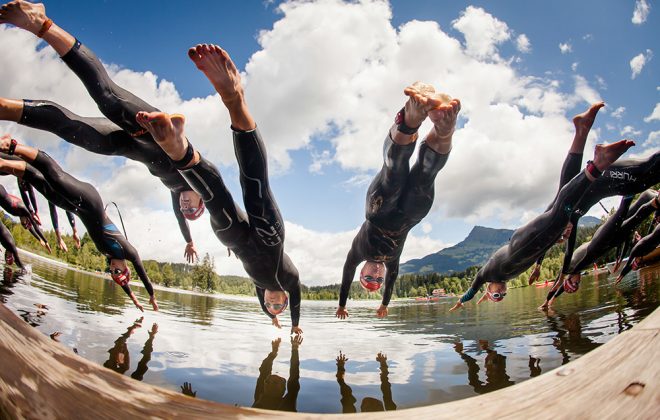Want To Run A Strong Trail Marathon? Try These 6 Proven Training Tips
Trail running is a sport for true nature lovers. Fresh air, beautiful scenery, sun (hopefully). However, with events looming on race calendar it’s easy to find yourself believing that to finish strong in a trail marathon more is better. More volume, more elevation gain, more carbs...
Trail running training is never easy. Beginners might struggle with ascents that spike their heart rate up. Seasoned athletes can suffer from muscle overload or injuries that come as result of the stress of fast downhills. More can sometimes lead to our bodies breaking down without receiving the intended adaptations.
An important part of trail running is feeling strong all around. That includes having the courage to take a step back to avoid an injury. It can be challenging to figure out how to balance volume, vertical meters and speed workouts in training. Not to mention cross-training and strength sessions.
These things matter when it comes to mountain running and finding the right balance can be a daunting challenge. However, through some experimenting and willingness to honestly listen to your own body, it is possible to figure out what works best for you. Finding your own balance will let you to train more effectively and realize your potential at a particular race.
If you’re looking for a trail running training plan, you’re in the right place. This post will help you lay the groundwork to get faster.

How to train for a trail run?
Recently I got the following email from an athlete whom I’ve coached in ultra marathon training. To protect his privacy, let’s call him Mark.
Hi Andrejs! So, last weekend, I ran the Innsbruck Trail Marathon. The original run (37k) was shortened due to snowy conditions, so I changed to the Marathon Distance – 42k and 1,700hm. My finish time was just over 5hrs and my previous time on this trail, which was a hard and warm one, was 6:34. Really in the backfield. I’ve followed your training scheme quite strictly and this time I was in the top 40% of the whole field. I’m really satisfied with how it went – I felt strong and in control. Some small muscle pains came in after 30k, but not unmanageable. I’m now looking forward to a run 2 months from now – 60K with 3,400hm, so training starts again. With more focus on strength to cope with the altitude I have to cover. Thanks again and speak soon!
I felt very proud with the progress that Mark was able to achieve in a span of just over 4 months. But more importantly, I was happy to hear that he was focusing on variety in his training, not on accumulating volume.
What we did with Mark was tweak his existing trail running schedule (without adding more training). His program was very basic – four to five easy runs per week (~5hrs total on average) and almost all of them in the mountains of Austria where he lived. That’s one gorgeous backyard to run in.
Effective trail running training plan
In essence, we made the following changes to Mark’s trail running schedule:
- Shortened some training sessions and made them more frequent (~6x/week)
- Established heart rate zones and training intensities
- Split training between mountain trails and road
- Placed focus on 2 key sessions per week (long trail run and speedwork)
- Added core training
- Created a pacing & nutrition plan
You can use the same strategy to get results in a trail race you’re training for. However, as they say, it’s not the plan that matters but the execution. So, for the plan to work and for improvements to be sustainable, a certain perspective is required. Scroll down to read more.
Read also: Core Training – 9 Mistakes To Avoid To Get Strong Abs (And More)
What makes a trail running training plan work?
As a coach, I’ve seen how athletes overcook themselves. They focus too much on ticking all the boxes (volume, elevation, speedwork, heat adaptation, etc.) and forget about the most important part of the process – themselves. Any good plan needs to be flexible, so that runners can experiment and find what combination of key factors works best for them. With Mark we’ve assigned top priority to recovery in order to ensure that he was fresh for key workouts. That gave him the freedom to execute his long and fast sessions on days when he felt the strongest.
The most important part of a trail running training plan is keeping track of how you feel and how the body is responding to the workload.
Being an ambitious group of individuals, athletes have a bad tendency to downplay how tired or sore they are on a daily basis. For some reason, the need for recovery is seen as a sign of weakness. Which it isn’t. Keeping a training diary can help to address that. Consistent practice of tracking how the body feels forces an athlete to take a step back and look at how things are going in a wider perspective. There’s plenty of parameters athletes can track – from tangible values, like resting heart rate, HRV or sleep, to intangible, like appetite or even muscle soreness. For example, when you notice you’re constantly feeling slow, have hard time on the ascents or can’t get your heart rate up, it can be a sign of fatigue accumulating.
And on that note, let’s move on to the practical ways how to train for trail running.
#1 Training consistency = key to a strong trail marathon
The first element of an effective trail running program is consistency. Frequent exercise does few things to the body. First, it builds strength in supportive muscle groups (i.e. stabilizers) and, second, develops resilience in the joints. Over time the body gets used to consistent impact, which makes trail runner more enduring and efficient. Especially when coming down a technical terrain.
Moreover, frequent exercise ensures that most of the training is done at low intensity (Zones 1 – 2). Since it’s not sustainable to train hard every day, the athlete will naturally slide down to an easy pace on most of his/her training runs. As a result, all that time spent at low intensity will create a strong endurance foundation for an athlete. In particular, grow mitochondria in the muscle tissue and improve fat oxidation, thereby improving the body’s efficiency.
Read also: Heart Rate Training Zones – Complete Guide To Endurance Gains
#2 How many miles should I run in a week to prepare for a trail race?
The weekly mileage for a marathon is a question with no clear answer. Training volume depends on many factors. How consistent an individual is with his/her training (and has been over the past). Or does an athlete experience pain anywhere in the body. What’s the current volume and, most importantly, does the lifestyle even allow to add more. Things like mental stress and non-training workload can really affect how much effort an athlete can put into training for a trail race.
For an experienced and competitive runner 10 hours per week can feel comfortable. For someone who’s starting out (or has a very busy life outside training) 4-5 hours can be more than enough. After all, it’s not the total volume that counts, but the quality of it. The more stress athletes go through – be it training load or stress of daily life – the longer recovery they will require to absorb the workload. When athlete put their bodies through more than they can handle, fatigue starts to accumulate, footwork gets sloppy and those additional efforts don’t bring expected benefit.
There’s a framework athletes can use to consistently progress:
Aim to build your weekly long run to ~2/3 of the distance in your peak period (5-8 weeks before the race), but keep it less than 30% of your total weekly volume.
Remember to build it gradually – start where you’re at and apply the 10% rule on a weekly basis. Maybe by the end of the program you’ll be able to cover only 1/2 of the distance. That’s ok too – as long as you’re consistent, you will develop the required resilience to go all the way on race day.

Cross training for trail runners – cycling
During running every time our foot hits the ground, a shock of 5-7 times our bodyweight travels through our entire body. That’s a lot of stress to process on daily basis. For comparison, cycling doesn’t have that shock impact, which makes it one of the best cross-training options for trail runners. Athletes who spend part of their training time on a bike can add quite a lot of training volume while putting little stress on their bodies.
Substituting running volume with cycling is a strategy that I personally used in my Ironman triathlon training to reduce injury risk. Moreover, many professional triathletes report spending less than 20% of their training time on running. And they can run a sub-2:50hrs marathon after 6 hours of intense exercise. Would they run faster if they focused on running? Most likely yes, but that could increase their injury risk.
I suggest injury-prone runners and those who wish to increase their volume substantially spend almost half of their running volume on the bike – be it indoors, on the road or on trails. Mix it up and feel free to even perform tempo or interval sessions on the bike. The fitness you’ll build with structured bike workouts will translate to trail running as well.
Cross training for trail runners – skiing
For trail runners a great form of mountain-running specific training is skiing. Specifically, ski mountaineering that requires climbing a mountain either on skis (using no-slip surface underneath) or by carrying them. Although, cross country skiing is also an activity that can support your training. The ultra-running legend Scott Jurek even came from cross-country skiing background.
From an aerobic base building stand-point, these activities can result in substantial boost to the heart and lung function. Also, thanks to significant vertical gains and muscular demands on nearly all muscle groups, skiing can build tremendous strength that will translate to gains in mountain running during summer months.

The Resilient Athlete
A Self-Coaching Guide to Next Level Performance in Sports & Life
Are you aiming to become a resilient athlete who is able to withstand any pressure? Be able to jump on any opportunity? Take any challenge life throws at you head on?
Then this book is for you.
Learn more#3 Vary the terrain when training for a trail race
One might expect that trail runners spend most of their training time going up and down mountain trails. However, quite a few of elite runners only spend a couple of days per week doing so and otherwise train on flat roads. Or on rolling hills at best. When they do go to the mountains, though, they ensure that the time is used for race-specific conditioning.
Effortlessness with which elite athletes are flying down technical terrain requires a lot of mental and physical effort.
Runners have to sustain a remarkable focus for extended periods of time while running downhill to remain vigilant to obstacles, like rocks or roots. This type of training also prepares their lower body to handle the impact of consistent pounding, so that they are able to run uphill or maintain the speed over flat terrain.
Even though running long mountain descents provides a lot of trail-specific training benefit, that is not the only thing that helps an athlete finish a trail marathon strong. Besides resilience athletes need power to go uphill and ability to run fast on flat sections of the route. Not to mention making some room for recovery in the training plan. That’s why trail runners who only do 2-3 focused mountain runs per week are better off and are able to absorb training better, because their bodies are able to recover quicker.
Can you train for a trail marathon on a treadmill?
The answer is yes. In case you don’t have access to mountain trails (which, let’s face it, many athletes don’t), you can still execute race-specific training sessions.
One option is to do your speedwork sessions on the treadmill where you can easily control intensity. Sessions like uphill tempo or Kenyan hill intervals are great at building fitness required to run a strong trail marathon and they are easy to execute on a treadmill.
Another way to prepare for a trail race if you’re not living in the mountains is to do your long runs on rolling hills or aim to gather as much elevation gain as possible within a single session. Use bridges, overpasses and even stairs to achieve that.

#4 Specificity and the best trail running workout
A good trail marathon training plan requires variety to make you a well-rounded athlete. But the program also needs to prepare you for specific race conditions. And there is one workout that can achieve that.
If you want to become an all-round better trail runner, you need to extend the time you spend in that environment – running (walking) up & down technical terrain. As they say, if you want to get good at something, practice it often. The weekly long run provides an opportunity for the best trail running workout, because it combines in itself all factors that affect trail running performance. So, if you have time for just one quality session per week – I suggest you organize it to be long easy run on terrain that simulates the race distance. Here are a few things to keep in mind:
- Duration: 2+ hours
- Intensity: keep in entirely in Zone 2. If you need to walk uphill to make that happen, that’s ok
- Elevation gain: see formula below
- Terrain: better make it on a trail (not asphalt or concrete) to minimize the shock on the body
- Come fully rested, hydrated and carb-loaded for this session
How to figure out how much elevation gain/loss to do on long runs?
In order to determine how much elevation gain/loss you should aim during your long trail runs, you can use the formula below. Use either miles & feet or kilometres (for distance) & meters (for elevation).
Elevation Gain = [ Race Elevation Gain / Race Distance ] x Long Run Distance
Let’s say you’re doing a 50km race with 1,800 meters of elevation gain/loss. You have a 30km long run scheduled. [ 1,800 / 50 ] x 30 = 1,080. That means you should be aiming for 1,080 meters of elevation gain during your long run. But don’t get too caught on numbers – this elevation gain/loss formula is to give you a benchmark only. Always consider how do you feel and how the body is absorbing the past workload.
#5 Strength training for trail running
Strength is the cornerstone of a well-balanced athlete. And it doesn’t matter if that athlete is in a speed, power or endurance-dominant sport. Nobody ever says to an athlete to run slower or throw weaker – it’s always higher, faster, stronger.
It’s even more relevant for ultra and trail marathon races, as those are not speed-focused events. Due to extensive muscle breakdown that happens on descents, running form deteriorates much quicker than during ordinary races. To be able to sustain that extensive muscle damage and still maintain a good pace an athlete must be strong across the entire body. That’s why these runs are sometimes referred to as strength runs.
While running on mountain trails helps to simulate the demand that is placed on the body during a marathon trail race, athletes will benefit from supplementing it with specific strength training for trail running. In particular, explosive strength exercises (i.e. power cleans and deadlifts), core strength and plyometrics to improve durability.
Read also: 12 Effective Strength Building Workouts For Any Experience Level
#6 Speed work for trail & ultra runners
That’s right. Speedwork comes at the very end. That is because a good trail runner has to have a solid foundation and be balanced in his training. Only then he/she will be able to benefits from focused speedwork. Unless other variables are not dialled in, high intensity will only put extra pressure on the body and will slow down the progress.
Adding high intensity to the plan is a form of art. Some athletes may benefit from alternating their training focus every other week. For example, one week include shorter hill repeats and lots of elevation change, while reducing overall mileage. The next week, the volume would increase, but the majority of the runs would be flat and the intensity of speed workouts would be closer to a tempo effort. Other athletes can thrive on having a more consistent schedule and maintaining a constant split between race-specific mountain runs and flat ones.
During the build phase the intensity of most speed sessions should be around the threshold effort – hard, but manageable for and extended period of time. We don’t need maximum efforts because the purpose is to develop aerobic power and aerobic capacity.
To avoid an injury, make sure you’re fully warmed up before running by doing some warmup and muscle activation exercises.

A typical speed session for a trail runner could include one of the following:
- 30min uphill run at tempo effort
- Kenyan hills – 3-4min uphill and 2min downhill maintaining the same pace (mid-Zone 4)
- Traditional hill repeats – 1-3min uphill (high-Zone 4)
Keep in mind that speed runs – just like those with lots of elevation change – require a substantial amount of recovery. Usually, two to three days. So, it’s a good idea to dedicate no more than two days to high intensity training. That way you will have enough time to recover for your key training sessions. Scroll down to the 16-week trail marathon training plan where I share typical training sessions.
Note for female runners: try to schedule high intensity training in the first half of your cycle. That’s when female body is the strongest and can process more training load. After ovulation (middle of the cycle), pay closer attention to how your body feels and aim to reduce the intensity and even take a recovery week during your period.
Sample 16-week trail marathon training plan
Finally, let me share with you the trail marathon training plan we’ve developed with Mark for his first race of the season. You can use the tips shared in this post to adapt it for your personal needs.
Keep in mind that Mark was training for an ultra marathon and the trail marathon race served as a practice race for him.
Foundation phase of trail marathon training (Weeks 1-4)
When Mark reached out to me he was already putting consistent 5-6 hours of training every week and was in a pretty good overall shape. So, we started by structuring his existing training and, in particular, over the course of a month changed his schedule from 4x/week to 6x/week.
Roughly half of that volume was on hilly terrain and the other half was flat. There was a tempo or interval session planned once every week, but the intensity of it was lowered to Zone 3 to avoid accumulating too much fatigue. Since the beginning of the program fell on winter months and Mark was switching some of his long runs to skiing in order to spend more time with the family.
If you don’t have a base of easy training, use the first 4-8 weeks to build up the volume and don’t add any specific speed work.
Another significant change we did early in the plan was to sacrifice 10-15min of running in favour of a short core or strength session. We scheduled that four times per week at the end of a run to simulate the effect of fatigue. Adding strength training so early in the plan gave Mark enough time to develop resilience needed to maintain form throughout his trail and ultra marathon races.
Typical sessions:
- 45min run in Zone 2 followed by 10-15min base strength or core routine
- 2hr run in Zones 1 – 2 on hilly terrain
- 2-4hr ski mountaineering session
- 45min Zone 1/2 run incl. 20min Zone 3 effort
Build phase of trail marathon training (Weeks 5-9)
During the build phase we increased the intensity of hill repeats to threshold level (high-Zone 4) and added Zone 4 inclusions into sustained tempo efforts. The goal was to improve power and aerobic capacity, so that Mark can be strong on the ascents.
Typical sessions:
- 45min run in Zone 2 followed by 10-15min core routine or power-focused strength session
- 2-3hr run in Zones 1 – 2 on hilly terrain
- Long (4-6min) hill repeats at threshold effort
- 30min uphill tempo in Zone 3 with short Zone 4 surges
Simulation phase of trail marathon training (Weeks 10-14)
Simulation was the key phase of Mark’s trail marathon training plan and took longer than usual (5 weeks). The reason was that Mark is an experienced runner and has already put in plenty of work on foundation, so he was able to recover well from extra workload.
Throughout this phase we focused on increasing the distance of long hilly runs and adding tempo efforts within them to simulate race intensity (on alternating weeks). Simulation phase is the best time to practice nutrition and pacing, as well as adapt to heat and altitude. With Mark we aimed to simulate race environment as much as possible for him to adapt better. Hence the name of the phase.
We also aimed to cover ~4hrs on hilly terrain 5 weeks before his trail marathon race, which at easy pace was close to 2/3 of the race distance.
Typical sessions:
- 45min run in Zone 2 followed by 10-15min core routine or power-focused strength session
- 2-4hr run in Zones 1 – 2 on hilly terrain, incl. up to 2hrs at Zone 3
- Long hill repeats at threshold effort
- Short hill repeats at VO2max effort
Taper phase of trail marathon training (Weeks 15-16)
Since most of the volume was easy we didn’t need a significant taper. All we did was reduce the overall volume by 30% and split intense efforts into shorter chunks. So, instead of doing 6x5min intervals, we did 15x2min.
You can read more about the taper plan in the post below.
Have an opinion? Share via links below and tag @theathleteblog
Andrejs
GET A FREE TRAINING PLAN
Subscribe to my email list and get access to a free 4-week “back in shape” training plan
You’ll also get two full-body strength sessions and some other goodies!

How did I get here?
Hey there! My name is Andrejs and I am here to inspire, entertain and get you fit for any adventure.
I went from being an over trained pro athlete to an endurance coach sharing how to listen to your body and live life to the fullest.
Traveling, new sports & activities brought new meaning to my training and made it much more effective, fun and enjoyable. And I'm here to help you do the same.


